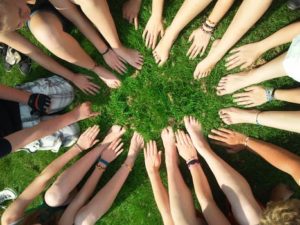Recent video evidence shows us the types of spaces that many white people believe should be for white people only: a Starbucks, a golf course, a dorm’s common area, a college tour, one’s own apartment, an Airbnb, etc. In this 50th year since the assassination of Dr. Martin Luther King, Jr., we still witness evidence that the enforcement of “Whites Only” did not disappear along with the posted signs. As our global society learns more about the countless communities formed among us, it is important to critically examine how we think about issues of belonging and how boundaries are formed and perceived.
“Whiteness is a political project and it is also a logic, by which I mean it is a calculus, a way of sorting oneself and others into categories of those who must be protected and those who are, or soon will be, expendable.” – Christina Sharpe
In the quote above, Sharpe speaks of the “calculus” involved in racism. An examination of one of the most important concepts in the field of community psychology reveals an example of such calculus. In 1986, scholars in the field of community psychology expanded on the construct called sense of community, also known as psychological sense of community. They defined it as “a feeling that members have of belonging, a feeling that members matter to one another and to the group, and a shared faith that members’ needs will be met through their commitment to be together” (McMillan & Chavis, 1986). The authors break this down to four elements: Membership, Influence, Integration and Fulfillment of Needs, and Shared Emotional Connection.
Though some scholars have rejected the detailed definition of sense of community as too individualistic and too utopian, without attention to structural inequalities (e.g., Wiesenfeld, 1996), the sense of community construct itself remains widely accepted and studied. Examining the first element, Membership, by itself, we find that this privileged imagining of community is one based in boundaries and exclusion. It is interesting that the critiques of the theoretical framework match the criticism levied against systems that perpetuate white supremacy: too individualistic and disregarding structural inequalities.

Membership is defined in this context as “a feeling that one has invested part of oneself to become a member and therefore has the right to belong.” Off the top and out of the gate, belonging is contextualized as a right instead of as an absolute truth of being. Though an individual can—and often does—belong to more than one community at a time, the individual’s relation to each community may differ in terms of feeling a natural belonging (e.g., an ethnic community) and the right to belong (e.g., a national community).
Why should an individual have to consider the right to belong to a community unless that right was not applicable to everyone? The right to belong is consistent with actual United States laws up until the 1960s, which were based on white persons, i.e., the white community, having rights that others did not. In fact, federal and state courts in the early 20th century decided numerous naturalization cases to ensure that the wrong people weren’t given rights reserved for whites (Haney Lopez, 1996). By legal and social design, the construction of and the perception of community in the United States is affected by white supremacy because the de facto enforcement of whites-only laws remains ever-present.
In the 1986 definition, membership is broken down to five attributes: boundaries; emotional safety; sense of belonging and identification; personal investment; and common symbol system. Examination of these attributes reveals the same sentiments of those who call the police to sanitize what they perceive to be white communities.
The first attribute of membership, boundaries, means that there are those who belong and those who do not. The examples provided in the theory to illustrate this were Puritans and gangs. The explanation goes on to specify that boundaries “separate ‘us’ from ‘them’ and allay anxiety by delimiting who can be trusted.” Here, community is seen as a matter of refuge from a real or imaginary enemy.

Relatedly, the next attribute, emotional safety, regards the idea of security. Membership criteria, the theory posits, establishes boundaries that safeguard structure and group intimacy. When white people call the police on Black people for their basic existence in a space, their complaints are about not feeling safe. This safety and security of community, then, is not for everyone. Furthermore, the alleged feelings of safety are in fact a mask for control and power.
Therefore, when police are called to protect and to serve, there is already an understanding that police will protect the white us and not the nonwhite them. Police, in this regard, can be classified as a community symbol. A common symbol system is another attribute of membership. For many different extensively studied reasons, symbols are important in communities; but, in the membership framework, they are assigned a specific purpose. According to sense of community theory, they serve to “maintain group boundaries” and “create social distance between members and nonmembers.” Reflecting on the police as a symbol of security and protection, we must also take into account that this symbolism is not the same in every community.

Another symbol is that of phenotype, including skin color, hair texture, and facial features that separate whiteness from everyone else. When the calculus of physiognomy is applied, phenotype is the most important symbol in the white community system. It is the deciding factor in membership, regardless of one’s feelings of belonging, identification, or personal investment.
Sense of belonging and identification is another attribute of membership. With this, one claims a group as their own, expecting to fit in and have a “place” in it. This is related to the personal investment attribute of membership, meaning a person works to earn that “place in the group,” making the membership “more meaningful and valuable,” according to the theory. Examples given for personal investment are college fraternities and homeowners—two exclusive types of communities, even beyond the systemic racial disparities in access to both. This envisioning of an ideal sense of community includes the inherent knowing that only some have the necessary means to secure a sense of belonging to that community.
These last two attributes, sense of belonging and identification and personal investment, resonate in the context of gentrification, which has been linked to this epidemic of wanton police calling by white people. Gentrification means that powerful people, exchanging resources amongst themselves, can select a disenfranchised location-based community, claim it as their own community, decide what investments are valid and necessary for people to belong to it, and make those investments while pushing out those who cannot make the newly required investments. Do the people who already live there get to declare that the community is their group and that they have the right to belong? Perhaps, but more powerful people and entities can invalidate that right and dismantle the existing community to benefit their own interests. Who belongs and who gets to experience a sense of community is a matter of power and resources.
Even Black people who have the right means and resources can have their emotional safety, sense of belonging and identification, and personal investment rejected by a community that perceives its spaces as white-only. Black people’s inability to display the most important symbol, the white phenotype, means that many white people still believe they do not have the right to belong. White people call the police for silly reasons that they implicitly perceive as matter of exclusively white rights; thus, the Black body violation of a white space. This boundary enforcement by white people through the power of the police has potentially deadly consequences for the Black body that had the audacity to occupy the contested “communal” space.
Recent research suggests that this way of viewing a community in terms of boundaries is not universal to all types of communities. A study of membership conducted with the Go-Go music-cultural community of the Washington, DC area provides evidence that community boundaries are more important to those who marginalize others (Mahdi, 2018). In the sense of community literature, community is discussed as “the group,” with gangs and other exclusive communities as examples. Yet, qualitative data from the Go-Go community demonstrates members’ perception of it as a community to which anyone can belong. The Go-Go community has been studied and described as a Black community and a marginalized one in the context of local politics and socioeconomics in Washington, DC and its suburbs. Our understanding of communities in the United States, then, is likely based on the legal, social, and economic realities of race and power.
The academic theorization of community membership is but one way in which the “calculus” of whiteness and whites-only communities is outlined. This white American cultural view of community as an exclusive group explains the continual, deliberate, painstaking, [mis]use of police force to exclude those who do not belong.
References:
Mahdi, T. C. (2018). Membership vs. being of the community: A qualitative study of the Go-Go music-cultural community (‘Bout-to-be-published doctoral dissertation). University of Maryland, Baltimore County.
McMillan, D. W., & Chavis, D. M. (1986). Sense of community: A definition and theory. Journal of Community Psychology, 14(1), 6-23.
Wiesenfeld, E. (1996). The concept of “we”: A community social psychology myth? Journal of Community Psychology, 24(4), 337-346.
- With editorial contributions made by Shawntay Stocks, M.A., Sherella Cupid, M.Ed., & Christopher A. Brown
